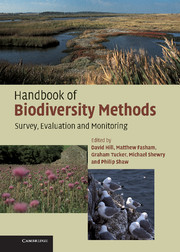Book contents
- Frontmatter
- Contents
- Preface
- Acknowledgements
- Part I Planning
- Part II Habitats
- Part III Species
- 9 Introduction to species assessment
- 10 General principles and methods for species
- 11 Fungi
- 12 Lichens
- 13 Bryophytes
- 14 Aquatic macrophytes and algae
- 15 Vascular plants
- 16 Dragonflies and damselflies
- 17 Butterflies
- 18 Moths
- 19 Other terrestrial invertebrates
- 20 Aquatic invertebrates
- 21 Fish
- 22 Amphibians
- 23 Reptiles
- 24 Birds
- 25 Bats
- 26 Other mammals
- Appendix 1 Monitoring and reporting obligations under international conservation agreements
- Appendix 2 Relationship between BAP Priority Habitat and Broad Habitat categories and Habitats Directive nomenclature
- Appendix 3 Annotated list of key references for plant identification
- Appendix 4 Determining appropriate quadrat size for vegetation sampling
- Appendix 5 The relocation of permanent plots
- Appendix 6 Equipment required for undertaking different types of survey
- Recommended sources of further information
- References
- Glossary
- Index
26 - Other mammals
Published online by Cambridge University Press: 01 September 2010
- Frontmatter
- Contents
- Preface
- Acknowledgements
- Part I Planning
- Part II Habitats
- Part III Species
- 9 Introduction to species assessment
- 10 General principles and methods for species
- 11 Fungi
- 12 Lichens
- 13 Bryophytes
- 14 Aquatic macrophytes and algae
- 15 Vascular plants
- 16 Dragonflies and damselflies
- 17 Butterflies
- 18 Moths
- 19 Other terrestrial invertebrates
- 20 Aquatic invertebrates
- 21 Fish
- 22 Amphibians
- 23 Reptiles
- 24 Birds
- 25 Bats
- 26 Other mammals
- Appendix 1 Monitoring and reporting obligations under international conservation agreements
- Appendix 2 Relationship between BAP Priority Habitat and Broad Habitat categories and Habitats Directive nomenclature
- Appendix 3 Annotated list of key references for plant identification
- Appendix 4 Determining appropriate quadrat size for vegetation sampling
- Appendix 5 The relocation of permanent plots
- Appendix 6 Equipment required for undertaking different types of survey
- Recommended sources of further information
- References
- Glossary
- Index
Summary
There is a wide variety of methods for surveying and monitoring mammal species. Given that mammal species range in size from mice to whales, the techniques will vary considerably from one species to the next. Methods can be divided into indirect methods (Sections 26.3.1–26.3.5), which involve counting signs of presence rather than the animals themselves, and direct methods (Sections 26.4.1–26.4.4).
ATTRIBUTES FOR ASSESSING CONDITION
Population size
Many mammal species are secretive and make effective use of cover; this makes direct counts, even of small sample populations, impossible. However, larger mammals, such as Red Deer Cervus elaphus occupying open ranges, can be effectively counted by direct counts. Estimates of population size for the majority of small and medium-sized mammals depend on indirect methods, such as indices of evidence left by mammals or trapping. Population reconstructions can be made from knowledge of the age at death of animals dying naturally or being culled, if a large proportion of the dead animals are available.
Breeding success and condition
Breeding success is particularly time-consuming to evaluate in mammals as it requires location of a sample of breeding sites and direct observation of young at these sites. Observer bias is also an important issue here as disturbance around a breeding site may attract predators.
Alternatively, breeding status can be evaluated by examining trapped females. In most mammals, from large to small, lactation is easily diagnosed and breeding condition can be established from examining the vulva, or taking vaginal smears for signs of oestrus.
- Type
- Chapter
- Information
- Handbook of Biodiversity MethodsSurvey, Evaluation and Monitoring, pp. 450 - 472Publisher: Cambridge University PressPrint publication year: 2005
- 1
- Cited by



